

By Eric Lindstrom
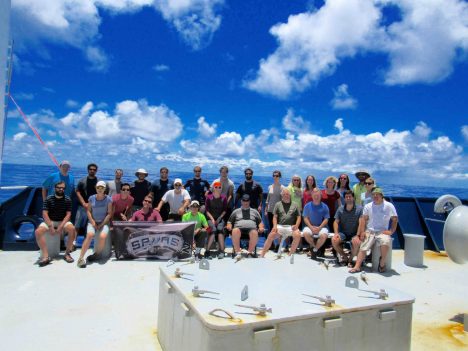
Science party on the R/V Revelle.
Salinity Processes in the Upper-ocean Regional Study #2 is underway for the next year. Lots of science remains to be done, so it is very early to be writing an epilogue! However, the first big field campaign with a large research ship is completed and it seems right to sum up some of the operational conundrums be articulated as we plan for further operations with the Lady Amber over the coming year and the R/V Thomas Thompson in October 2017.
Conundrum#1: Finding “Just Right”
Like Goldilocks, the R/V Revelle team went in search of very special conditions. Conceptually, SPURS-2 is built around observing all the processes that lead to rainfall mixing into the ocean and the resulting large-scale variations of salinity that we detect from space.
One of the concepts is that rain falling into the ocean will reveal itself as low salinity “lenses” at the surface than mix into the ocean over time. Well, not unexpectedly, if the wind is anything but calm, the rain mixes quickly into the upper ocean mixed layer and cannot be seen as a lens – only tiny variations of salinity that build up over time. In order to see the strong signal of a lens of fresher water, one needs to observe the ocean during calm winds and rain. The difficulty with this is finding the simultaneous occurrence of rain and low wind conditions in a vast ocean with a platform with a top speed of about 12mph. During SPURS-2, it became apparent that the regions with more certain rainfall (those large cells and fronts visible from space) were also stormier and windier than ideal for measurement. In areas of calm winds, there are patches of rainfall but they don’t seem predictable (“It’s the tropics” says Jim Edson!)
So, the perfect observing condition for us were more difficult to find than we expected ahead of time. Probably no surprise that mother nature throws a great curve ball! In the end, we targeted the low-wind regime by following the surface wind forecasts and hoped to run into rain (which we did). After a few weeks at sea we learned and prevailed.
Conundrum#2: Risk
It is always tricky to balance risk and reward. Equipment deployed at sea is always at risk of loss. The reward for taking the risk is valuable data to expand our scientific understanding. We had several occasions to examine and balance these risks and rewards.
For example, the CODE drifter was an instrument that was modified ashore by addition of a salinity sensor but not tested prior to shipping five of them to R/V Revelle. In the parlance of oceanography, drifters float at the surface, while floats are neutrally buoyant and can sink and return to the surface to transmit profiles of the ocean. In a test deployment of one drifter, it appeared to stay at the surface (just), but when released from the ship it simply sank, never to be seen again! Not the behavior you like to see in a drifter! So, although modification to its four sister drifters were undertaken, it was eventually decided that these drifters were not ready for prime time. Lucky we tested one! The small experiment with CODE drifters will have to wait until next year.
The Lighter-Than-Air InfraRed System (LTAIRS) balloon deployments were quite complicated by variations in the balloon lift during rain and by variations in wind speed and direction. Dipping the balloon payload (expensive camera) in the water is a big risk. However, the data – infrared movies of the sea surface skin temperature in rain – are super interesting and scientifically novel. We learned a lot about making waterproof payloads, the best material and size of balloons, and weather characteristics unfavorable for ballooning. This knowledge was hard won with near misses and close calls and exhaustion of the helium supply. We all think it cost our chief scientist Andy Jessup some new gray hairs! However, the grin on his face when he shows you the data is priceless. Well worth the drama and risk in the process. LTAIRS work will go more smoothly next year on the R/V Thompson and the team will likely make some interesting discoveries about the thermal properties of the sea surface during rain.
Final Thoughts
It was a great pleasure to work with and support the scientists and crew on R/V Revelle. It is a capable ship and crew and the science party was very well prepared for the challenges and risks. Morale was high during the entire voyage – maintained by a busy schedule, everyone pitching in, and good food and fellowship. The teams from University of Washington Applied Physics Laboratory, University of Connecticut, Woods Hole Oceanographic, and Scripps Institution of Oceanography came to R/V Revelle super-prepared and ready for action. The schooner, Lady Amber, will be making periodic voyages during the coming year to service and renew out drifting (Lagrangian) experiment. As always, your blogger enjoyed every minute of our six weeks at sea. Its wonderful to watch scientists and engineers face the challenges of understanding the ocean while in its grip. I’ll keep you posted on developments during the coming year!
By Eric Lindstrom

The SPURS-2 science party on the R/V Revelle.
The R/V Revelle expedition has been the opening round in a yearlong effort to understand the upper ocean physical processes in the eastern tropical Pacific. We put moorings in place to collect a time series of upper ocean measurements over the year. We launched the first round of Lagrangian drifters and floats. Lady Amber will be servicing these assets at regular intervals and launching new drifters and floats into the array.
It is with some caution and caveats that I try to summarize our findings from the last six weeks of effort. Ideas are still young and data processing is still in its early phases. Only data from shipboard measurements are complete but still require careful screening, calibration, and validation. Despite the caveats, some of our questions and challenges are much clearer now than before we left Honolulu.
The Conductivity, Temperature and Depth (CTD) work, led by Janet Sprintall, charting the variations of temperature, salinity, and oxygen in the upper ocean, revealed some quite interesting features. Janet and her team will be looking at salinity-compensated temperature inversions in the upper ocean that seem to be closely associated with the edges of the east Pacific fresh pool.
Jim Edson and Raymond Graham have a wonderful three-week time series of 80 atmospheric profiles from their radiosonde launches via weather balloons every six hours. Ray will be working these up for his MS degree research project, so I won’t steal any of his thunder. Needless to say, we all think he will have an awesome project because it is such a rich data set!
Ray also assembled all the rainfall data daily and found that during SPURS-2 we had about 10 inches of rainfall in our 3 weeks on site near 10N, 125W.
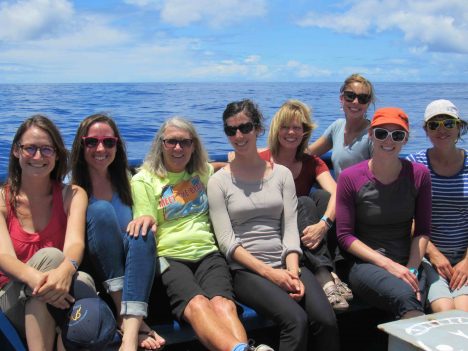
The women of SPURS-2.
Carol Anne Clayson has collected more than 1,500 air-sea flux estimates (20-minute averages) to be analyzed in conjunction with the upper ocean data sets from numerous platforms. She has already been able to run her mixed layer model using initial conditions from early in the expedition and the raw flux estimates to compare with later expedition measurements. It gives us great optimism for new discoveries out of this data set.
Michael Reynolds brought the Remote Ocean Surface Radiometer (ROSR, from Andy Jessup) and the Infrared Sea surface temperature Autonomous Radiometer (ISAR, from Carol Anne Clayson) to SPURS-2 to examine the surface skin temperature of the ocean during rainfall. Michael successfully engineered the instruments for this purpose (normally a fair weather measurement). He has put together some exciting compilations of data comparing his measurements with other temperature measurements made on the ship.
Julian Schanze from Earth & Space Research in Seattle is the man with the Salinity Snake. It has provided a virtually continuous record of the salinity in the top 2 inches of the water column. Julian has identified nearly 40 fresh lenses where salinity at the surface is significantly lower than ship intakes at 6.5 feet (2 meters), 9.8 feet (3 meters), and 16.4 feet (5 meters depth). These measurements, when further combined with the Surface Salinity Profiler data from the upper 3.3 feet (1 meter), will constitute a rich data set for analysis of fresh water lenses induced by rainfall.
Ben Hodges from Woods Hole Oceanographic Institution (WHOI) has been following the three Wavegliders deployed near the SPURS-2 central mooring. They have salinity sensors near the surface and at 19.7 feet (6 meters) depth and will be hard at work over the entire coming year. One of the Wavegliders had an experimental package of sensors on it called the salinity “Rake” with sensors at every 3.9 inches (10 centimeters) depth from the surface to 3.3 feet. The Rake, invented by Raymond Schmitt at WHOI, recorded data internally and was recovered after a few days of operation to check functionality (it has not been to sea before). The data is amazing; but it only lasted one day before mechanical failure and short circuits took it out of commission. However, that vertical resolution and the interesting features that it saw were a new peek at the ocean surface salinity that really has not been seen before. More engineering work needs to be done at home before it can be re-deployed. The team at Woods Hole will be highly motivated to get this instrument to sea again soon, based on what we saw in just one day. The Waveglider was re-deployed without the Rake.
The Surface Salinity Profiler (SSP) team led by Kyla Drushka has a very successful run with 18 deployments (not counting various tests and trials). The data is still being assembled and examined but, like the Rake measurements, the SSP focus on the top 1 m of the ocean is going to provide new insights on ocean processes. The SSP has the added benefit of microstructure probes to provide information on turbulent mixing. The biggest difference in salinity seen over 3.3 feet by SSP was 9 units!
Eric Chan had the rare opportunity to focus a study on the air-sea exchange of carbon dioxide during rain events. The simultaneous analysis of his gas exchange data with the salinity snake and meteorological data will be enlightening. Certainly the raw carbon dioxide data show the dip in pCO2 expected during rain events when the salinity drops.
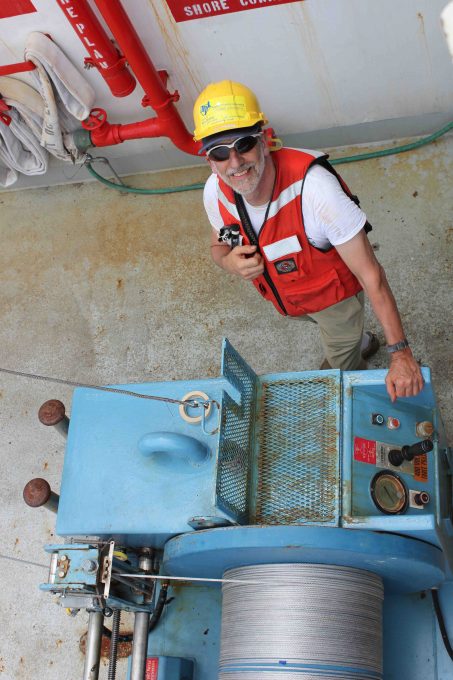
Andy Jessup, voyage chief scientist, at work.
Finally, I’d like to heap praise on our chief scientist, Andy Jessup, who managed execution of all the projects and requirements with great skill and diplomacy. The whole SPURS-2 team owes Andy a great deal for making the R/V Revelle expedition such a successful initiation of the SPURS-2 Program.
Next blog post: PORT!
By Eric Lindstrom
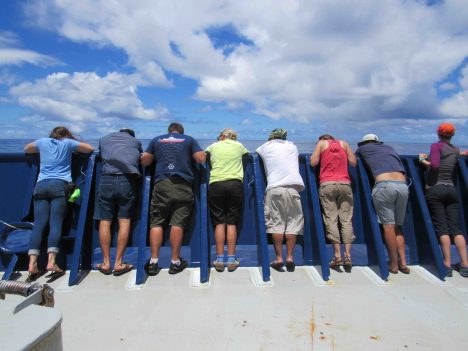
Are we there yet?
A six-week voyage on the open ocean is not for everyone. On this trip we had plenty of veterans and few first timers. Channel fever is commonly considered something that happens at the end of a voyage as you head for port. It is maybe easier for those of you ashore to picture as akin to spring fever at the end of winter. I would like to describe a more comprehensive theory of voyage feelings that is more akin to the five stages of grief. Maybe it should be called the five stages of channel fever?
For grief, the five stages are denial, anger, bargaining, depression and acceptance. For channel fever, the five stages are sickness, interest, boredom, excitement, and port. Like grief, they are not some stops along a linear timeline (except maybe port!), but tools to help us recognize what we are thinking and feeling. In this theory of channel fever it occupies the entire voyage.
Sickness
Getting your sea legs is the first hurdle of the voyage. It starts in the harbor channel and impacts people in different ways. Headaches, queasiness, and overwhelming sleepiness are all symptoms. This phase is definitely a downer and modern medicine has sought to treat it with drugs. Some unfortunates never get past this stage.
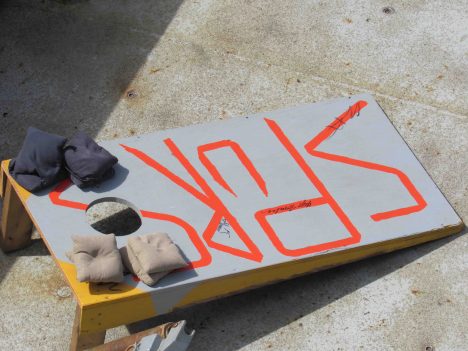
A game devised to forestall channel fever.
Interest
A core feeling early in voyages is interest in all the stuff that other people are doing that of which you have not yet become familiar. The ship is small, so any new things to see or do certainly focus your attention. Good mariners can make the simplest chores and routines the subject of great interest and focus. They know that you should hold this feeling as long as possible. It’s deadly if you move on to boredom too soon. Maybe my blogging style gains strength from this stage of channel fever?
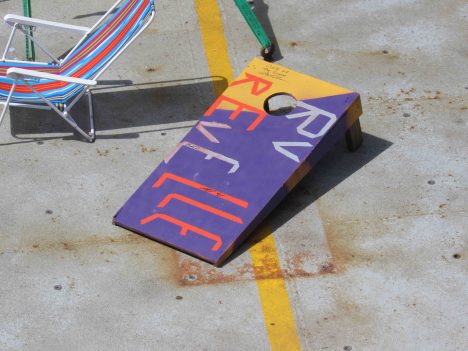
Two teams, eight bean bags and two targets = hours of amusement.
Boredom
Once you have mastered your work and everyone else’s chores, interest fades and boredom takes over. Ideally, you would like this feeling to be minimized. Therefore, sea veterans are adept at invention of new games, procedures, routines, and making anything that is even halfway interesting last as long as possible. You may have wondered why people come back from sea with weird new skills like knot tying or macramé. It’s because of trying to fight boredom!
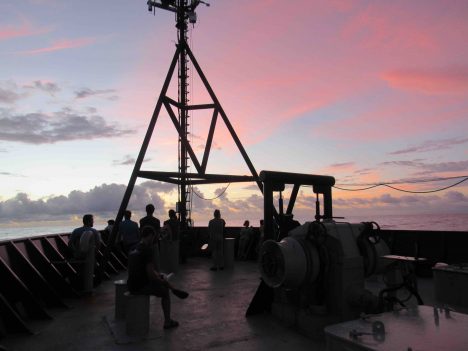
End of a long day of packing and dreaming of home.
Excitement
This is the classic feeling of channel fever and its penultimate stage. Long after sickness, interest, and boredom, it is usually the time when all your hopes hang on finishing the trip and getting back to life ashore. Usually this stage alone is what people refer to as channel fever because the emotional symptoms are closely associated only with proximity to voyage end and no other known cause.
Port
The final stage of channel fever and resolution (in my theory) of the malady come with arrival in port and being homeward bound. Resolution (port) is often a highly celebrated event. The modern cure for channel fever is solid ground and a cold beer. Really, we don’t know if beer has anything to do with this, however there seems to be a close association between beer and miraculous recoveries in port! The science party on R/V Revelle is hosting a post-voyage happy hour ashore later in the day we arrive, just to make sure everyone receives the cure.
Cheers!
By Eric Lindstrom

Our mixed-up Monkey looks everywhere for microstructure probes.
One of the challenges of oceanography (and many other sciences) is telling a coherent story of the environment across a vast space of space and time scales. For example, cosmologists tell the story of the universe from subatomic particles to the breath of the visible universe and from first nanoseconds of the big bang to billions of light years.
For SPURS-2, mixing is obviously an important factor in telling the story of how rainwater combines with seawater to bring about the east Pacific fresh pool that we see from space. That mixing primarily happens in the upper ocean at scales of centimeters, where turbulence is caused by phenomena such as wave breaking, current shears, convection in unstable layers, and the rain itself hitting the sea surface. In order to understand the big picture, we need to estimate the magnitude and location of the centimeter scale turbulent mixing.
Over many decades oceanographers have become quite adept at estimating mixing from measurements of centimeter scale temperature, salinity, and velocity variations – otherwise known as microstructure. Now, along with our standard instruments for measuring temperature and salinity, we also deploy microstructure probes – very fast sampling sensors of ocean variables.
It is beyond the scope of this blog to explain how microstructure measurements are transformed into ocean mixing estimates, but it is one of the more helpful developments in modern oceanography.

Caitlin Whalen, working on her review article for the Bulletin of the American Meteorological Society.
Caitlin Whalen of the University of Washington Applied Physics Laboratory (APL) is an expert in ocean mixing. While on the SPURS-2 expedition, she has contributed to a review paper on the subject for the Bulletin of the American Meteorological Society. During SPURS-2 she oversaw the addition of the Seagliders to the Lagrangian experiment.
The Seagliders will provide us with a picture of how the turbulence in the SPURS-2 region varies at deeper depths and over a longer time period than we will learn form our ship-based measurements. Over the next six months the Seagliders will repeatedly travel between the ocean surface and a depth of one kilometer, collecting data during each trip. From this data we will be able to determine how the turbulence in the ocean varies with depth and how it is related to other events such as heavy rain and the continuously changing density patterns of the water. Knowing where and when turbulence occurs will help us understand how the fresh rainwater eventually mixes deep into the salty ocean.

Dan Clark and Kyla Drushka of APL make final adjustments of the SSP microstructure probes.
Kyla Drushka and Suneil Iyer, also from APL, have deployed microstructure probes on the Surface Salinity Profiler (SSP). They will try to determine, from these measurements and the vertical structure of salinity in the upper meter of the ocean, how quickly rain-formed low salinity lenses are mixed into the upper ocean during individual events. Their big challenge during SPURS-2 has been to get a snapshot of salinity lenses at various stages of their lifetime. Being in the right place (low wind conditions) at the right time (just as rain begins to fall) with the right gear (SSP) actually deployed has been challenging. Still, I am sure we have collected more such data this expedition than previously existed. Finally enough data to find great exemplars for discussion in the scientific community! This is a wonderfully “fresh” topic for a graduate student like Suneil to tackle.

Kyla Drushka and Caitlin Whalen from APL, hard at work in the rain.
Just about everyone doing analysis of SPURS-2 data will use estimates of mixing in some way or another in the telling of their part of the story of salinity in the eastern tropical Pacific. It will be part of any salinity budget calculations and used in the description of salinity fronts. It will be an essential part of the story in explaining the seasonal patterns of salinity we see from space. The story of the smallest scales in the ocean meets up with the story of the planet as seen from space!
By Eric Lindstrom
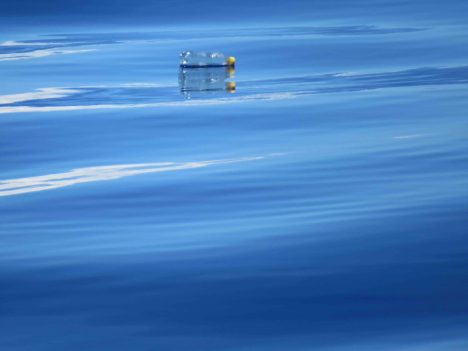
Plastic bottle floating by the ship.
A 1960’s movie classic, “The Graduate” (1967), contains a scene where the young Benjamin Braddock (Dustin Hoffman) is given advice about his future by the worldly Mr. McGuire (Walter Brooke):
Mr. McGuire: I want to say one word to you. Just one word.
Benjamin: Yes, sir.
Mr. McGuire: Are you listening?
Benjamin: Yes, I am.
Mr. McGuire: Plastics.
A report from the World Economic Forum earlier this year estimates that the weight of plastic in the ocean will equal the weigh of fish by 2050. According to the report the worldwide use of plastic has increased 20-fold in the past 50 years and is expected to double again in the next 20 years.
Ocean pollution by plastic has been worrisome for years, but the global prevalence of plastic in the ocean and the full impact of its consequences are more recently appreciated. Plastic breaks down at sea into “microplastics” that are now part of the floating plankton – the base of the food web in the ocean. So, plastic is increasingly found in the stomachs of marine organisms. Recent estimates put the amount of plastic floating in the world’s oceans at more than 5.25 trillion pieces weighing more than 268,000 metric tons. That translates to as much as 100,000 pieces per square kilometer in some areas of the ocean. This is a new ocean habitat know as the plastisphere.
The plastisphere is a new waterfront mobile home for marine microorganisms. It potentially provides a floating home for microbes to take long tours of the ocean that were heretofore impossible. The ecological implications of this new globalization of the ocean microbial biota have yet to be determined.
Zooplankton and fish consume microplastics as they forage the plankton. Scientists think that nearly every bird that feeds at sea has a burden from the plastisphere as they forage the small fish. Given the rapidly increasing tonnage of plastic joining the plastisphere and the plastisphere invasion of the marine food chain, we too will be doing battle with the plastisphere, if not already.
Marine debris is not all plastic and has many sources. However, dumping from ships at sea is NOT the major source. Dumping at sea has been highly regulated for more than 30 years. The major source of plastics and other debris in the ocean is from land sources and river runoff.
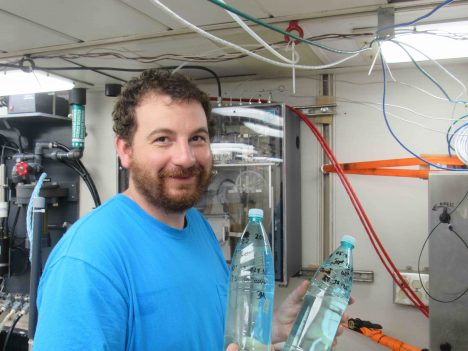
Dan Clark with two of his nearly 50 bottles of samples for investigation of ocean microplastics.
In SPURS-2 we are very far from land – 7.5 days transit by ship from the Hawaiian Islands. Yet, still, we spy plastic bottles, shoes, fishing gear, and other unidentifiable debris at the surface of the ocean every day. We also have evidence that microplastics exist here. A UV filter, part of the water intake to one of R/V Revelle’s new thermosalinograph systems (Underway Salinity Profiling System) inadvertently acts as a microplastics sampler. Floating plastics, fibers and ocean detritus accumulate in the UV filter chamber that used to sterilize the saltwater sample prior to salinity sensing. The debris in the filter must be cleaned frequently to keep the system in working order and prevent bioaccumulation in salinity sensor. This thermosalinograph system was not designed for studying ocean debris, but it is a plenty worrisome observation. Dan Clark from University of Washington’s Applied Physics Laboratory is keeping the daily samples for analysis after SPURS-2. This a nice example of citizen science undertaken through the curiosity and personal initiative of Dan over and above his many other duties. Now he just has to figure out how to deal with the unusual sampling protocol!
The ocean is actually quite forgiving as a disposal site for human detritus in moderation, except plastic. Organics can be recycled by marine life, wood is disposed of quickly by boring worms, metals can be corroded by seawater, but plastic cannot be dissolved or digested. It is only humans who create and produce plastic goods. It is only humans who can dispose of plastic properly. Plastic MUST be recycled or disposed in landfills. Plastic has no business being in the ocean. We can only hope that the plastisphere we have created can be tamed and that it does not spawn deadly new microbes by virtue of its existence.
So, next time you are using a plastic good, make sure its afterlife is not in the plastisphere of the ocean. Benjamin’s retort to Mr. McGuire should have been “Yes. Mr. McGuire. Plastics are the future. If we can find proper ways to dispose of them!”